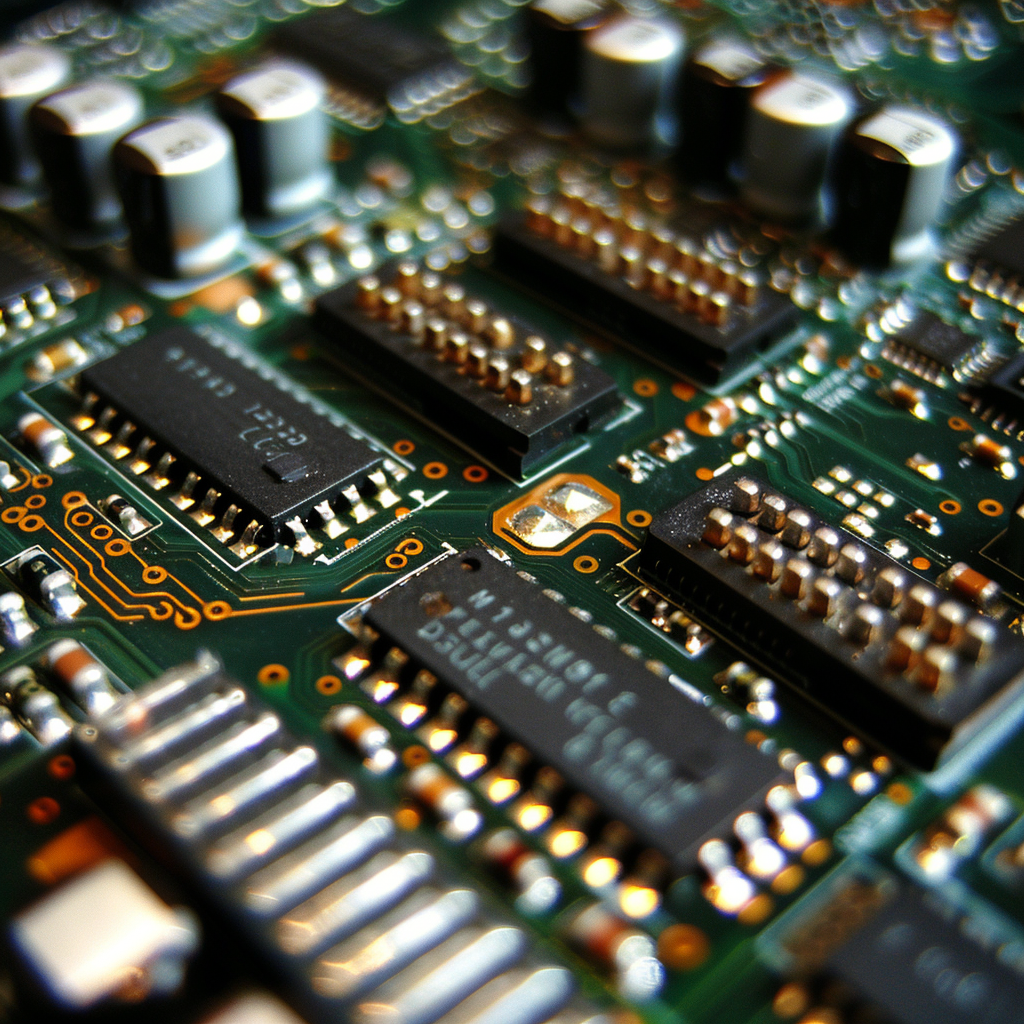Time: 2024-02-23 15:06:18View:
A microcontroller is a small, self-contained computer system on a single integrated circuit (IC) chip. It combines a processor core, memory, and input/output peripherals, making it a complete computing system in a compact form. Microcontrollers are designed to execute specific tasks and are commonly used in a wide range of electronic devices and embedded systems.
For more information, please refer to this blog: An Overview of Microcontroller
Microcontrollers play a crucial role in the functioning of automobiles, providing control and coordination for various systems and components. Here's an expanded explanation of how microcontrollers work in automobiles:
1. Engine Control: One of the primary functions of microcontrollers in automobiles is engine control. Microcontrollers, often referred to as engine control units (ECUs), monitor and regulate the engine's performance. They collect data from various sensors, such as the throttle position sensor, oxygen sensor, and temperature sensors, to determine the engine's operating conditions. Based on this information, the microcontroller adjusts fuel injection timing, ignition timing, and other parameters to optimize engine performance, fuel efficiency, and emissions.
2. Transmission Control: Microcontrollers are responsible for managing the operation of the transmission system in automobiles. They receive input from sensors that monitor vehicle speed, engine load, and driver inputs. Based on this data, the microcontroller determines the appropriate gear shifting points and controls the transmission solenoids or actuators to engage the gears. Microcontrollers in modern vehicles often incorporate advanced algorithms and adaptive learning to optimize gear shifts for smooth acceleration, fuel efficiency, and overall performance.
3. Safety Systems: Microcontrollers are integral to various safety systems in automobiles. For instance, they control the anti-lock braking system (ABS) to prevent wheel lock-up during braking. Microcontrollers monitor wheel speed sensors and modulate brake pressure to each wheel individually for optimal braking performance. Additionally, microcontrollers manage electronic stability control (ESC), traction control systems (TCS), and other safety features, continuously monitoring vehicle dynamics and making necessary adjustments to ensure stability and control.
4. Airbag Deployment: Microcontrollers are involved in the functioning of airbag systems. They receive signals from crash sensors that detect the severity and type of impact. Based on this information, the microcontroller determines the appropriate timing and intensity for deploying the airbags. Microcontrollers play a critical role in ensuring that the airbags are deployed accurately and efficiently to protect the occupants during a collision.
5. Climate Control: Microcontrollers are utilized in automotive climate control systems to regulate temperature, airflow, and other comfort parameters. They receive input from temperature sensors and cabin occupancy sensors to determine the desired interior climate. The microcontroller then controls the operation of the heating, ventilation, and air conditioning (HVAC) system, adjusting fan speed, temperature settings, and airflow distribution to maintain the desired comfort level inside the vehicle.
6. Instrumentation and Display: Microcontrollers are employed in the instrumentation and display systems of automobiles. They process data from various sensors and communicate with the vehicle's dashboard displays and gauges. Microcontrollers control the speedometer, fuel gauge, temperature gauge, and other indicators, providing real-time information to the driver. They also enable the integration of advanced features like navigation systems, infotainment displays, and driver assistance systems.
7. Body Control: Microcontrollers manage the electronic systems and functions related to the vehicle's body control. These include controlling power windows, central locking systems, exterior lighting, and other electrical components. Microcontrollers receive input from switches and sensors, allowing the driver to control various functions conveniently. They also provide safety features like automatic door locking and interior lighting control based on vehicle status and driver inputs.
In summary, microcontrollers in automobiles serve as the central processing units that control and coordinate various systems and components. They receive input from sensors, process data, and execute algorithms to ensure optimal performance, safety, and comfort. Microcontrollers in automobiles are designed to withstand harsh environments, operate reliably, and adapt to changing conditions, making them essential for modern vehicle functionality.

Microcontrollers offer several advantages in automotive applications, but they also have some limitations. Here's an expanded explanation of the advantages and disadvantages of using microcontrollers in automobiles:
Advantages:
1. Compact Size: Microcontrollers are small and lightweight, making them ideal for space-constrained automotive environments. Their compact size allows for easy integration into various vehicle systems without occupying excessive physical space.
2. High Processing Power: Despite their small size, microcontrollers possess sufficient processing power to handle complex tasks. They can execute multiple instructions quickly, enabling real-time control and response in automotive systems.
3. Flexibility and Programmability: Microcontrollers are programmable, allowing for flexibility in adapting to different automotive applications. They can be reprogrammed or updated with new software to accommodate changing requirements or add new features, providing scalability and future-proofing.
4. Integration of Peripherals: Microcontrollers incorporate numerous built-in peripherals, such as analog-to-digital converters (ADCs), timers, communication interfaces, and more. This integration simplifies the design and reduces the need for additional external components, leading to cost savings and improved reliability.
5. Real-Time Control: Microcontrollers are well-suited for real-time control applications in automobiles. They can rapidly process sensor data, make decisions, and execute control algorithms with precise timing, ensuring accurate and timely responses in critical systems like engine management, safety systems, and transmission control.
6. Low Power Consumption: Microcontrollers are designed to operate efficiently on low power, which is crucial for automotive applications. They can perform tasks while consuming minimal electrical power, contributing to improved fuel efficiency and extended battery life.
Disadvantages:
1. Limited Processing Power: While microcontrollers offer sufficient processing power for most automotive applications, they may have limitations when it comes to handling highly complex or computationally intensive tasks. In such cases, a more powerful computing platform may be required.
2. Memory Constraints: Microcontrollers typically have limited program and data memory compared to other computing platforms. This limitation can restrict the amount of code and data that can be stored and processed, potentially impacting the complexity and functionality of automotive systems.
3. Development Complexity: Developing software for microcontrollers requires specialized knowledge and skills in embedded programming. The process involves low-level programming languages like C or assembly language, which can be more challenging to work with compared to higher-level programming languages.
4. Cost: While microcontrollers themselves are relatively affordable, the overall cost of implementing microcontroller-based systems in automobiles can increase due to the need for additional components, sensors, and peripherals. Additionally, the cost of development, testing, and validation of microcontroller-based systems can be significant.
5. Limited Upgradability: Microcontrollers are often tightly integrated into automotive systems, making it difficult to upgrade or replace them individually. Upgrading a microcontroller-based system may require modifications to the entire system, including hardware and software components.

It's important to note that advancements in microcontroller technology continually address some of these limitations, offering improved performance, increased memory capacity, and enhanced functionality for automotive applications.
The future trends of microcontrollers in automobiles are driven by the rapid advancement of technology and the evolving needs of the automotive industry. Here's an expanded explanation of the future trends for microcontrollers in automobiles:
1. Increased Processing Power: As automotive applications become more complex, there is a growing demand for microcontrollers with increased processing power. Future microcontrollers will feature more advanced architectures, higher clock speeds, and improved performance to handle the computational requirements of emerging technologies like autonomous driving, advanced driver-assistance systems (ADAS), and in-vehicle infotainment systems.
2. Integration of Artificial Intelligence: The integration of artificial intelligence (AI) capabilities into microcontrollers will be a significant trend. AI algorithms, such as machine learning and deep learning, will enable microcontrollers to analyze vast amounts of data from sensors and make intelligent decisions in real-time. This will enhance the capabilities of autonomous driving systems, intelligent traffic management, and predictive maintenance.
3. Enhanced Connectivity: Future microcontrollers will have increased connectivity options to support the growing demand for connected car features. They will incorporate advanced wireless communication interfaces, such as 5G, Wi-Fi 6/6E, and V2X (vehicle-to-everything) communication, enabling seamless connectivity with other vehicles, infrastructure, and the cloud. This will facilitate vehicle-to-vehicle (V2V), vehicle-to-infrastructure (V2I), and vehicle-to-cloud (V2C) communication, leading to improved safety, traffic efficiency, and enhanced user experiences.
4. Integration of Security Features: With the increasing connectivity and complexity of automotive systems, ensuring robust cybersecurity will be a crucial trend. Future microcontrollers will incorporate advanced security features to protect against cyber threats, unauthorized access, and data breaches. These may include hardware-based encryption, secure boot mechanisms, intrusion detection systems, and secure communication protocols, providing a secure foundation for vehicle systems and protecting sensitive data.
5. Energy Efficiency: Microcontrollers in automobiles will continue to focus on energy efficiency. Future microcontrollers will feature improved power management techniques, low-power modes, and advanced energy harvesting capabilities to optimize energy consumption. This will contribute to increased fuel efficiency in internal combustion engine vehicles and extended battery life in electric and hybrid vehicles.
6. Heterogeneous Computing Architectures: To meet the diverse requirements of automotive applications, future microcontrollers may adopt heterogeneous computing architectures. This involves combining different types of processing units, such as general-purpose cores, specialized accelerators, and digital signal processors (DSPs), to provide a balance between performance, power efficiency, and task-specific optimizations.
7. Safety and Functional Safety: As safety remains a top priority in the automotive industry, future microcontrollers will incorporate enhanced safety features and functional safety mechanisms. This includes compliance with industry standards like ISO 26262, redundancy in critical systems, fault detection and diagnostics, and fail-safe/fail-operational capabilities. These measures will ensure the reliable and safe operation of microcontroller-based automotive systems.
8. Rapid Prototyping and Development: The future trend of microcontrollers in automobiles will also involve improved tools and frameworks for rapid prototyping and development. This will enable faster design iterations, efficient software development, and easier integration of microcontrollers into automotive systems. Development platforms with pre-built software libraries, simulation tools, and hardware-in-the-loop (HIL) testing capabilities will facilitate faster time-to-market for automotive applications.
In summary, the future trends of microcontrollers in automobiles include increased processing power, integration of AI capabilities, enhanced connectivity, improved security features, energy efficiency, heterogeneous computing architectures, emphasis on safety and functional safety, and advancements in rapid prototyping and development tools. These trends will shape the next generation of microcontrollers, enabling advanced automotive functionalities and addressing the evolving needs of the automotive industry.